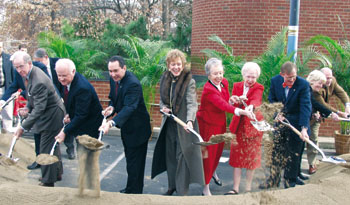
Ground was officially broken Saturday for the Vanderbilt Bill Wilkerson Center for Otolaryngology and Communication Sciences and Musculoskeletal Institute. Construction of the eight-story building on 21st Avenue is expected to be completed in 2003. Pictured are, from left, Monroe Carell Jr., Fred Bess, Ph.D., Dr. Robert Ossoff, Martha Ingram, Jane Yount, Nancy Fawn Diehl, Gordon Gee, Judy Simmons, and Dr. Harry Jacobson. (photo by Tommy Lawson)
VUMC gauges
salary system
In July, for the first time at VUMC, annual staff salary increases were based on individual performance evaluation scores. Performance development provides the basis for pay-for-performance. It’s an annual cycle in which managers and staff members plan and evaluate individual performance per the VUMC mission, credo, and job descriptions.
“Vanderbilt is achieving improved staff satisfaction due in part to performance development, which has brought improved two-way communication with managers and better understanding of compensation,” said Susan Mezger, director of Human Resources Programs. Overall staff satisfaction rose from the last survey held three years ago. On the survey question, “I am satisfied with my work group’s performance development/appraisal system,” VUMC scored 3.15 (out of 5), compared to a health care national average of 2.91, and a VUMC 1998 score of 2.68.
This year 100 percent of staff received a performance evaluation per the performance development program. “It took a lot of people working together to get there,” said Kristi Skeeters, a Human Resource Services representative whose work is focused on performance development.
On July 1, staff with performance scores of 3.0 to 3.7 were awarded a 3.25 percent pay increase; those with scores of 3.8 to 4.4 were awarded a 3.75 percent increase; and those with scores of 4.5 to 5.0 were awarded a 4.25 percent increase. Staff with scores below 3 were ineligible for a pay increase.
Human Resource Services held open sessions in August specifically to gather staff feedback on the pay-for-performance program, and feedback sessions were scheduled with various groups of managers and nurses. Earlier this month, feedback and points of clarification were presented to managers.
The feedback sessions helped Human Resource Services and the Total Compensation Committee identify any aspects of the pay-for-performance program that may be in need of immediate clarification. “The goal is to avoid major changes to these programs for at least the first three years,” Mezger said. “When you do something new, it must have the opportunity to take root before an accurate assessment and resulting changes can be made.”
• Managers say the performance rating descriptions were not sufficient to guide them in assigning scores for performance. The descriptions have already been clarified in preparation for next year.
• Performance scores were found to be inconsistent from one department to the next. Reports have been distributed comparing individual departments with overall VUMC scoring and with the recommended distribution of scores (see chart). Managers with skewed scoring patterns should review job descriptions and performance criteria, Mezger said.
• Staff and managers want to see more differentiation in the pay increases. It’s expected that education for managers will help create consistency between departments and with score distribution guidelines. Once this consistency is achieved, differences in pay increases may be more pronounced.
• Staff and managers had questions about how transfer within VUMC meshes with performance evaluation and pay increases. These issues will be studied and clarified in preparation for next year.
For more information on performance development and pay-for-performance, visit the Web site, www.vanderbilt.edu/HRS.













